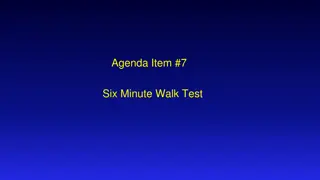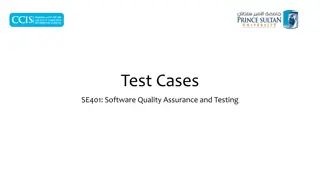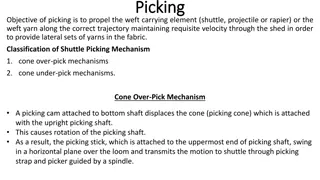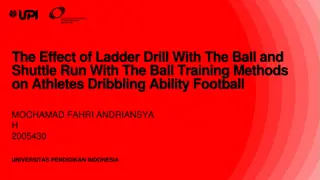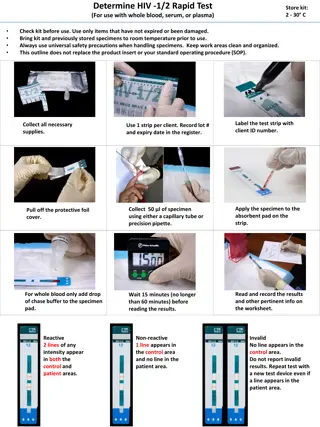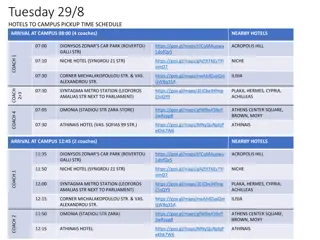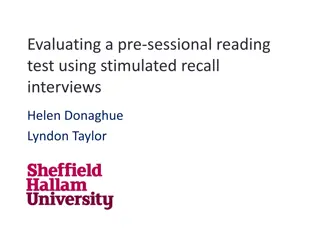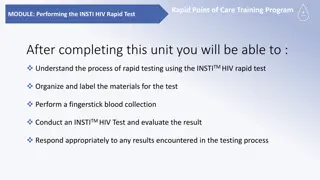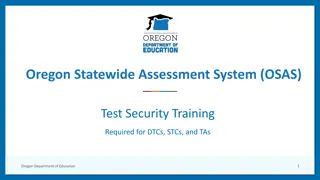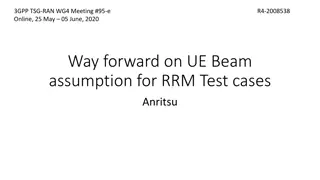Shuttle Walk Test
The Incremental Shuttle Walk Test (ISWT) is a field walking test designed to simulate a cardiopulmonary exercise test. Participants walk around cones set 9 meters apart to auditory cues, gradually increasing speed. The test ends when the participant can no longer keep up or becomes too breathless. Standardization is crucial for accurate results, with specific guidelines for testing frequency and conditions. The ISWT offers valuable insights into physical fitness and endurance.
Download Presentation

Please find below an Image/Link to download the presentation.
The content on the website is provided AS IS for your information and personal use only. It may not be sold, licensed, or shared on other websites without obtaining consent from the author.If you encounter any issues during the download, it is possible that the publisher has removed the file from their server.
You are allowed to download the files provided on this website for personal or commercial use, subject to the condition that they are used lawfully. All files are the property of their respective owners.
The content on the website is provided AS IS for your information and personal use only. It may not be sold, licensed, or shared on other websites without obtaining consent from the author.
E N D
Presentation Transcript
StudyMafia.Org Shuttle Walk Test Submitted To: Submitted By: Studymafia.org Studymafia.org
Table Contents Definition Introduction About Shuttle Walk Test Before the Shuttle Walk Test After the Shuttle Walk Test Conclusion 2
Definition The incremental shuttle walk test (ISWT) was developed to simulate a cardiopulmonary exercise test using a field walking test. 3
About Shuttle Walk Test The patient is required to walk around two cones set 9 metres apart (so the final track is 10 metres) in time to a set of auditory beeps played on an app. Initially, the walking speed is very slow, but each minute the required walking speed progressively increases. 4
About Shuttle Walk Test The patient walks for as long as they can until they are either too breathless or can no longer keep up with the beeps, at which time the test ends. The number of shuttles is recorded. Each shuttle represents a distance of ten metres (i.e each time the patient reaches a cone is 1 shuttle). 5
About Shuttle Walk Test Standardisation of the ISWT is very important for obtaining meaningful outcomes. The ISWT must be measured on twice to account for a learning effect. Please note that: The best result is recorded. If the repeat test is performed on the same day, 30 minutes rest should be allowed between tests. 6
About Shuttle Walk Test Debilitated individuals may require tests to be performed on separate days, but aim for tests to be less than one week apart. Only standardised instructions from the app should be used. In contrast to the six-minute walking test, no encouragement should be given throughout the ISWT. 7
About Shuttle Walk Test A comfortable ambient temperature and humidity should be maintained for all tests. The walking track must be the same for all tests for a patient: Cones are placed nine metres apart. The distance walked around the cones is 10 metres. 8
Before the ISWT Instruct the patient to dress comfortably and to wear appropriate footwear. Any prescribed inhaled bronchodilator medication should be taken within one hour of testing or when the patient arrives for testing. The patient should rest for at least 15 minutes before beginning the ISWT. 10
Before the ISWT Record: Blood pressure. Heart rate. Oxygen saturation. If a patient is on inhaled vasodilator therapy this should be administered 30 minutes prior to the exercise test. 11
After the ISWT The ISWT ends if any one of the following occur: The patient is more than 0.5 m away from the cone when the beep sounds (allow one lap to catch up). The patient reports that they are too breathless to continue. The patient reaches 85% of predicted maximum heart rate (maximum heart rate = 210 0.65 x age) 12
After the ISWT The patient exhibits any of the following signs and symptoms: Chest pain that is suspicious of / for angina. Evolving mental confusion or lack of coordination. Evolving light-headedness. Intolerable dyspnoea. Leg cramps or extreme leg muscle fatigue. Persistent SpO2 < 85%. 13
After the ISWT Seat the patient or, if the patient prefers, allow to the patient to stand. Immediately record oxygen saturation (SpO2)%, heart rate and dyspnoea rating. Two minutes later, record SpO2% and heart rate to assess the recovery rate. Record the total number of shuttles. 14
After the ISWT Record the reason for terminating the test. The patient can be asked: What do you think stopped you from keeping up with the beeps? The patient should remain in a clinical area for at least 15 minutes following an uncomplicated test. 15
Conclusion The change in the distance walked in the ISWT can be used to evaluate the effectiveness of an exercise training program and / or to track the change in exercise capacity over time. The minimal important difference in the distance walked is an improvement between 35m to 58m.8 16
References Google.com Wikipedia.org Studymafia.org Slidespanda.com
Thanks To StudyMafia.org


![Read⚡ebook✔[PDF] Linking the Space Shuttle and Space Stations: Early Docking Te](/thumb/21519/read-ebook-pdf-linking-the-space-shuttle-and-space-stations-early-docking-te.jpg)
![[PDF⚡READ❤ONLINE] Energiya-Buran: The Soviet Space Shuttle (Springer Praxis Book](/thumb/21613/pdf-read-online-energiya-buran-the-soviet-space-shuttle-springer-praxis-book.jpg)
![Read⚡ebook✔[PDF] The Untold Stories of the Space Shuttle Program: Unfulfilled D](/thumb/21685/read-ebook-pdf-the-untold-stories-of-the-space-shuttle-program-unfulfilled-d.jpg)



